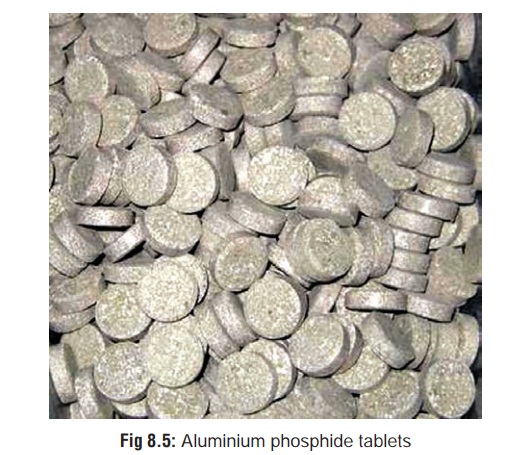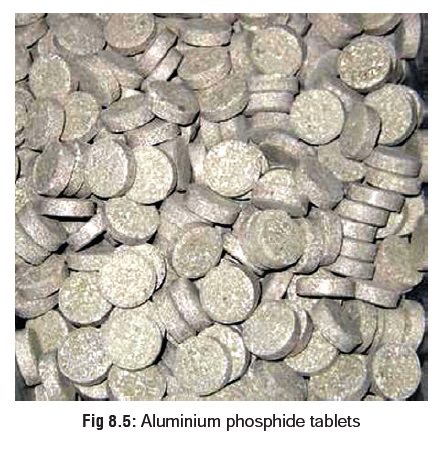Chapter: Modern Medical Toxicology: Chemical Poisons: Non-Metallic Chemical Poisons
Aluminium Phosphide - Chemical Poisons

Aluminium Phosphide
Physical Appearance
·
Aluminium phosphide is marketed in
India under various trade names (Alphos,
Bidphos, Celphos, Chemfume, Delicia,Fumigran, Phosphotek, Phosphume, Phostoxin,
Quickphos, Synfume, etc.).
·
It is generally available as greyish
green tablets of 3 grams each, mixed with urea and ammonium carbonate (Fig 8.5). These tablets are sold in
sealed, airtight containers of tens and twenties. Each tablet liberates 1 gram
of phosphine.

Uses
·
Grain
preservative: Aluminium phosphide is said to be themost ideal grain preservative
since it is relatively cheap while being very effective in repelling pests. The
required number of tablets are removed from the airtight container and placed
among the grain. On exposure to moisture, phos-phine is released which
percolates among the grain. When fumigated grains are subsequently well
aerated, phosphine evaporates rapidly leaving behind virtually no residue.
Traces of phosphite and hypophosphite of aluminium may be present, but they are
non-toxic.
Usual Fatal Dose
One
to three tablets.
Mode of Action
When
exposed to air and moisture, aluminium phosphide liber- ates phosphine which
causes multi-organ damage.
AlP
+ 3H2O→Al(OH)3
+ PH3
Clinical Features
·
Common presenting symptoms include
metallic taste, vomiting, garlicky (or fishy) odour of breath, intense thirst,
burning epigastric pain, and diarrhoea.
·
In severe cases, there are
cardiovascular manifestations
o Hypotension
o Tachy/bradycardia,
and ECG abnormalities: sinus tachycardia, sinus arrhythmia elevation, atrial
fibrillation, T wave inversion in V5-6, sinus arrest, chaotic atrial pacemaker,
complete heart block, bundle branch block, and ventricular premature complexes followed
by ventricular tachycardia.
o Massive
focal myocardial injury with elevated serum levels of cardiac enzymes may
occur.
·
Convulsions have been reported in
some cases. Coma supervenes in later stages.
·
Hepatic damage, renal failure, and
metabolic acidosis are possible.
·
Respiratory distress is invariably
present with cyanosis, and cold, clammy skin.
Diagnosis
·
Garlicky odour in the breath.
·
Urinalysis may reveal occult blood,
bilirubin, glucose, and albumin.
·
Liver function tests are often
abnormal.
·
Blood urea and serum creatinine are
usually higher than normal.
·
Hypo/hypermagnesaemia;
hypo/hyperphosphataemia.
·
ECG changes (mentioned under Clinical Features).
Qualitative
tests for detecting phosphine in the breath and gastric aspirate:
i.
Breath
test: A piece of filter paper impregnated with 0.1 N silver
nitrate solution is used in the form of a mask through which the patient is
asked to breathe in and out for 5 to 10 minutes. Blackening of the paper is
indicative of the presence of phosphine in the breath, since silver nitrate is
reduced to silver on exposure to it. Similar reaction is also produced by
hydrogen sulfide.![]()
ii.
Biological
sample test: A small amount of gastric apirate(5 to 10 ml) or minced
tissue (5 to 10 gm of liver)* is taken into a steam distillation flask to which
an equal quantity of water is added and then acidified with dilute HCl or H2SO4,
followed by heating upto 500C for 15
minutes. The distillate is collected in an ice cold receiver containing 5 ml of
1% silver nitrate solution by dipping the adapter into it. If phosphine is
present, the solution will turn black.
For
confirmation, add 5 ml of concentrate.HNO3 to the black precipitate
and boil till the solution becomes clear. Then add 5 ml of ammonium molyb-date
solution and heat for a minute. Formation of a yellow precipitate confirms the
presence of phos-phine.
A
variation of this test involves placing 0.1 N lead acetate filter paper over
the mouth of the distillation flask containing the sample (prepared in the same
manner as detailed above). The flask is heated for 15 minutes at 50oC.
Phosphine will blacken the silver nitrate paper, while hydrogen sulfide will
blacken both papers.
Treatment
·
Emesis is not to be induced. Though
there is often intense thirst, do not administer water since whatever aluminium
phosphide is still remaining in the stomach will react with it, releasing
phosphine. For the same reason, stomach wash is contraindicated. While
activated charcoal can be administered, it should be mixed with sorbitol (and
not water), using 240 ml for every 30 grams. However, some authorities
recommend the performance of gastric lavage as well as the administration of
activated charcoal using aqueous solutions.
·
While there were initial reports
eulogising the efficacy of magnesium sulfate, particularly in relieving
cardiovas-cular manifestations, later studies could not sustain such view.
·
Presently the suggested measures
include the following:
i.
Management of circulatory shock with
IV fluids (4 to 6 L over 6 hours), while monitoring the central venous
pres-sure and/or pulmonary wedge pressure. Dopamine can be given IV at a dose
of 4 to 6 mcg/kg/min (maximum 10 mcg/kg/min).
ii.
Management of respiratory distress
with 100% humidi-fied oxygen, intubation, and assisted ventilation.
iii.
Management of metabolic acidosis
with sodium bicar-bonate (50 mEq/15 min) until the arterial bicarbonate rises
above 15 mmol/L.
iv.
Control of convulsions with
anticonvulsants (benzo-daizepines, barbiturates, etc.).
v.
![]() Magnesium sulfate therapy*: Magnesium sulfate issaid to be
beneficial in the management of cardiac arrhythmias. Conventional
antiarrhythmic drugs such as digoxin and lidocaine are ineffective.
Magnesium sulfate therapy*: Magnesium sulfate issaid to be
beneficial in the management of cardiac arrhythmias. Conventional
antiarrhythmic drugs such as digoxin and lidocaine are ineffective.
o Magnesium
sulfate is given IV as a 3 grams bolus, followed by 6 grams infusion over 24
hours for 5 to 7 days.
o Alternatively,
1 gram can be given IV to begin with, followed each hour by the same dose for 3
consecutive hours, and then 1 gram every 6 hours for 5 days.
·
Ranitidine 50 mg IV 8th hourly to
counter the severe epigastric pain.
Autopsy Features
·
There is widespread hypoxic organ damage
with congestion and petechiae.
·
Contents of stomach are often
haemorrhagic with mucosal shedding, and there is usually an intense garlicky
odour.
·
Microscopy reveals necrotic changes
in liver and kidneys.
·
Heart shows features of toxic
myocarditis with fibrillar necrosis.
·
Lungs may demonstrate evidence of
ARDS (adult respira-tory distress syndrome) with or without pulmonary oedema.
Forensic Issues
Prior
to 1980, aluminium phosphide poisoning was virtually unreported in India. Today
it is the leading cause of suicidal (and sometimes accidental) death in
northern Indian states such as Punjab, Haryana, Uttar Pradesh, Madhya Pradesh,
and Rajasthan. Southern states have so far not been signifi-cantly affected
since aluminium phosphide is yet to make inroads into the agricultural sector
here. But there are ominous indications of a gradual rise in the number of
cases being reported.
Related Topics